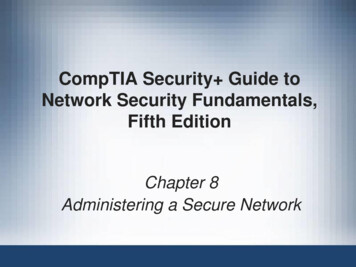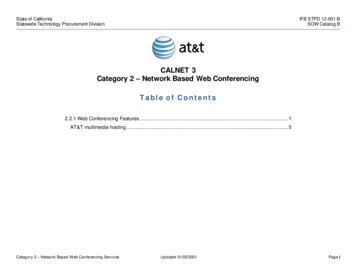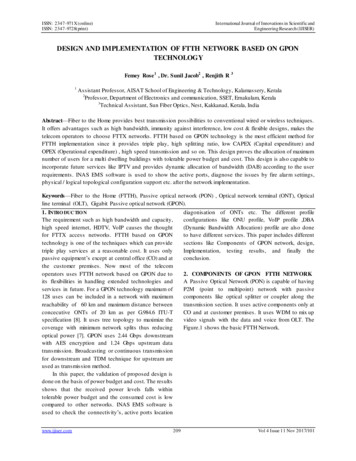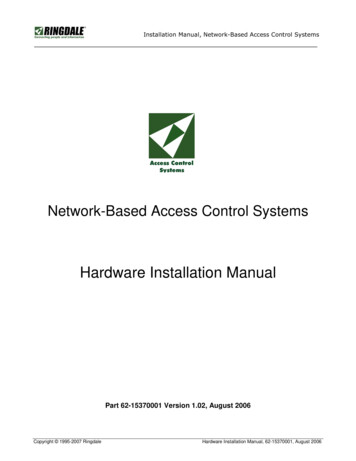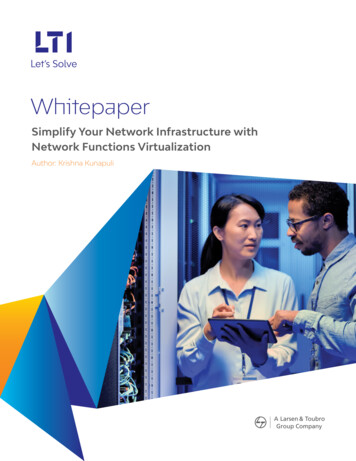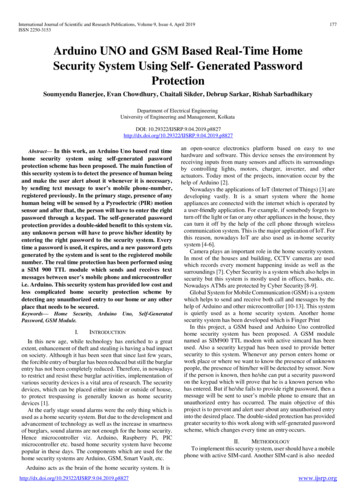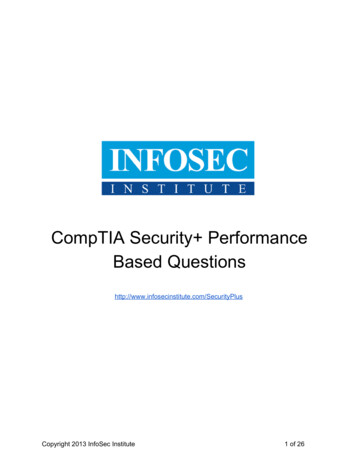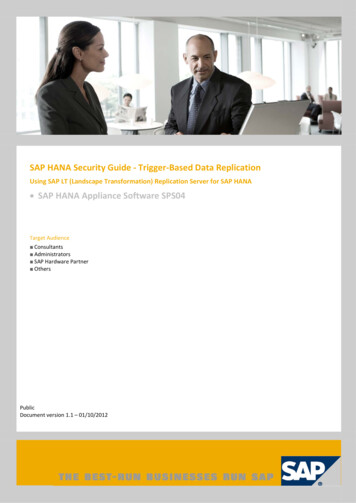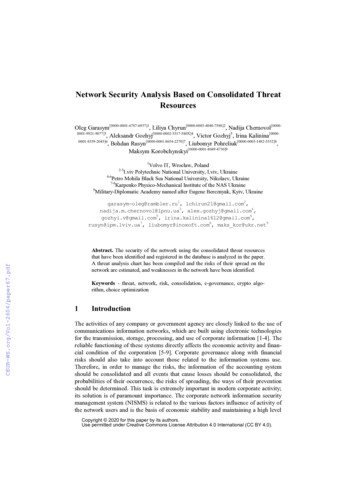
Transcription
Network Security Analysis Based on Consolidated ThreatResourcesOleg Garasym[0000-0001-6787-6937]1, Liliya Chyrun[0000-0003-4040-7588]2, Nadija Chernovol[00000001-9921-9077]3, Aleksandr Gozhyj[0000-0002-3517-580X]4, Victor Gozhyj5, Irina Kalinina[00000001-8359-2045]6, Bohdan Rusyn[0000-0001-8654-2270]7, Liubomyr Pohreliuk[0000-0003-1482-5532]8,Maksym Korobchynskyi[0000-0001-8049-4730]91Volvo IT, Wrocław, PolandLviv Polytechnic National University, Lviv, Ukraine4-6Petro Mohila Black Sea National University, Nikolaev, Ukraine7-8Karpenko Physico-Mechanical Institute of the NAS Ukraine9Military-Diplomatic Academy named after Eugene Bereznyak, Kyiv, Ukraine2-3garasym-oleg@rambler.ru1, lchirun21@gmail.com2,nadija.m.chernovol@lpnu.ua3, alex.gozhyj@gmail.com4,gozhyi.v@gmail.com5, irina.kalinina1612@gmail.com6,rusyn@ipm.lviv.ua7, liubomyr@inoxoft.com8, maks kor@ukr.net9Abstract. The security of the network using the consolidated threat resourcesthat have been identified and registered in the database is analyzed in the paper.A threat analysis chart has been compiled and the risks of their spread on thenetwork are estimated, and weaknesses in the network have been identified.Keywords - threat, network, risk, consolidation, e-governance, crypto algorithm, choice optimization1IntroductionThe activities of any company or government agency are closely linked to the use ofcommunications information networks, which are built using electronic technologiesfor the transmission, storage, processing, and use of corporate information [1-4]. Thereliable functioning of these systems directly affects the economic activity and financial condition of the corporation [5-9]. Corporate governance along with financialrisks should also take into account those related to the information systems use.Therefore, in order to manage the risks, the information of the accounting systemshould be consolidated and all events that cause losses should be consolidated, theprobabilities of their occurrence, the risks of spreading, the ways of their preventionshould be determined. This task is extremely important in modern corporate activity;its solution is of paramount importance. The corporate network information securitymanagement system (NISMS) is related to the various factors influence of activity ofthe network users and is the basis of economic stability and maintaining a high levelCopyright 2020 for this paper by its authors.Use permitted under Creative Commons License Attribution 4.0 International (CC BY 4.0).
of corporate security. To protect corporate information, especially confidential information, administrators need to make timely and informed management decisionswhile processing consolidated information about threats and network weaknesses [1016]. Consolidated corporate network security information allows you to obtain comprehensive network status information and effectively monitor events, identify attacks, faults and vulnerabilities, and isolate corporate information security threats.Based on the consolidated information, diagnostics, control and adaptation of information security management, direct security control are carried out. Adaptation ofinformation security management is necessary to meet the desired results, despitechanging corporate governance goals, technological conditions, or expanding corporate operations. Based on the consolidated information [1-2, 17-21], the network vulnerability assessment and prevention of possible intrusions are created, the corporateinformation security management strategy [3-4, 22-29] is adjusted accordingly, themethods and data protection methods are determined, and the appropriate decisionsare made to identify hidden information threats.2Relate the highlighted issue to important practical andscientific workThe classification of functional elements of network security and the categorization ofnetwork security technologies of basic functional elements provide the basis for astructured approach to the study of heterogeneous technologies that are rapidly evolving [30-35]. An organized, hierarchical view is used to represent all traditional, modern and emerging network security technologies. Fig. 1 shows a structure that reflectsan organized, hierarchical view of the technology of functioning of corporate communications information security systems [5-6].Fig. 1. Architecture of technologies of functioning of systems of protection of information ofcorporate communication networksIn order to maintain such architecture, the corporate communications informationsecurity system should be operated using consolidated security resources that arisethroughout the system to prevent network attacks from progressing. By collecting all
the data from each security technology into a single consolidated resource, it is possible to identify the weaknesses of the security system and accordingly take timelymeasures to enhance the security of vulnerable sites and be able to predict events.The resultant task of network security is to secure the application systems and information used at the input and generated at the output. As a result, you can identifythe basic functional elements of a corporate network security that are necessary tobuild and operate a NISMS [36-42]: Confidentiality,Authentication,Authorization,The integrity of the message and the inability to opt out of authorship / receive themessage [7-8].These functional corporate network security elements are used in both hardware andsoftware execution on network devices (switches, servers, etc.) within the path defined by the two endpoints of the communication connection (preferably a client PCor terminal and server) [9-10]. It is important to note that not all of these functionalelements are always contained in separate elements of a corporate network securitysystem. In addition, there are network security services that are difficult to attribute tothese functional elements, but that work together with them to provide the desirednetwork security capabilities [11-12]. The relevance of theme is due to the need forconstant monitoring of network security and effective response to factors that disruptthe network [43-51]. For information security management, consolidation of data onthreats that negatively affect the state of the network is a prerequisite for work. Thisapproach provides an opportunity to solve management problems: forecasting damagefrom threats, identifying weak links of information protection and, accordingly, contributes to the creation of projects of management decisions to improve the protectionsystem [52-59]. Consolidated threat accounting resources are created not only foroperational and current management, but also for the purpose of making long-termdecisions and predicting malicious actions of attackers. The aim of the work is tosubstantiate the theoretical concept of consolidation of data on threats of the corporatecommunication network and integration of the results into the information securitymanagement system based on the analysis of consolidated resources, effective planning, control and decision-making by the information security management system.To achieve the goal, the following tasks were set: To identify threats to the network;Determine the activities of the NISMS;To carry out the consolidation of identified threats;Assess the risks of proliferation and impact of threats;Research of weak links of a network.
3Recent research and publications analysisConsolidated information is obtained from multiple sources and systematically integrated multifaceted information resources, which are collectively endowed with thefeatures of integrity, completeness, consistency and constitute an adequate information problem area model for its processing, analysis and effective use in decision support processes. A corporate communications network management system must haveprocedures in place to monitor and monitor the quality of its work. These proceduresdetermine the compliance of the corporate network with the strategic plan of the corporation and the analysis of the impact of specific risks on its overall activity. In particular, they include checking the functions of electronic channels of informationdelivery, their compliance with the strategic plan of activity; the ability of electronictools to process the intended amount of information [13-14].The management system procedures determine whether the corporation's management and responsible units receive the information they need and examine the functioning of each electronic system implemented, analyze it, including: Determining whether various aspects of the functioning of electronic systems aretaken into account, including analysis of critical cases, failures; Definition for each electronic system that cooperates with the main operating system of the corporation, databases their compatibility and security; Verification of the accuracy and intelligence of scheduling software, calculations,etc. available through the communications network; Determining whether a duplicate system is in place for users in the event that eservices systems do not operate for an extended period; Check for the developed procedures existence for notification of the managementof the management system in case of technical problems of the network; Checking for the distribution of physical access to computer equipment, software,communications equipment and communication lines with clearly identified personnel, depending on their functions and positions within the corporation [10].The organization of the corporation's activities must be tailored to the conditions ofuse of electronic means, so incompetence of management or imperfect technologyused can affect the economic condition of the institution. Also, an existing organization of activities may not provide sufficient protection for sensitive electronic information. Existing procedures and procedures may not take into account the speed oftransactions and the extended reach of electronic channels that transmit corporateinformation. Therefore, the management system includes:1. Observation of operating procedures and procedures, which is to determine theirsuitability in the conditions of use of electronic channels of information transmission. Determines whether the applicable work organization procedures for the applicable personnel meet the requirements of implementation in new corporateproducts and services; how electronic technologies affect information transmissionchannels. A corporation must have a proper security system that includes the following elements:
Control access and protection of confidential information of clients; The methods for determining the right of request of each participant in electronicdata transmission systems; Highlighting information that may be accessible to third parties.2. Determination of the ability to improve procedures and procedures in accordancewith the use of electronic technologies to ensure access and change of confidentialinformation: What information and how it is allowed to be transmitted to third parties; Whether confidential information is part of contracts and agreements with thirdparties that are hired by the corporation.3. Determining the existence of mandatory authorization procedures. The presence ofprotection of tracking and prevention of duplicate transactions in each electronicsystem is confirmed. The quality of client training regarding security and safetywhen using electronic corporate systems is checked. Periodically, according to theestablished schedule, the entire spectrum of transactional corporate capabilities ischecked, the resources of activity of each segment of the secure corporate communication network are consolidated, the operational procedures and procedures forconducting transactions and compliance with the requirements of protection andsecurity of corporate information [15].Effective management of information security requires understanding of networkattacks. As a rule, attacks are carried out in several steps.The first is research or network intelligence. The attacker collects informationabout the use of the target database and documents, the availability of monitoringtools for the corporate network. Then the attacker tries to identify vulnerabilities inthe hardware, software or organizational information security, continues additionalresearch and looks for a tool that can disrupt the work. Attack detection systems classify scans as low threat because they do not harm servers or corporation activity.Scanning is a prerequisite for attacks. If the port is found open or unsecured, then theattacker usually goes into the pre-attack phase. Some services and applications aretargets for attack. Despite the use of security technology, network administrators mustaddress the challenge of protecting systems from malicious attacks and accidentalfailures. One method called intelligence is used by hackers to select networks anddomains to search for targets. Intelligence allows a hacker to identify targets for attack or use them for attack [16].4Statement of a problemThe assessment of the risks associated with a breach of protection must identify,quantify and decide on their prevention. The results should guide and determine theappropriate management action and the risk management priorities associated withthe breach of information security, as well as the implementation priorities of theselected management tools, to protect against these risks. The risk assessment andmanagement selection process can be performed several times to cover different partsof the organization or individual NISMS.
The risk assessment should include a systematic assessing the magnitude methodfor the risks (risk analysis) and a process of comparing the predicted risks against therisk criteria in order to determine the significance of the risks. Risk assessmentsshould also be undertaken periodically to take account of changes in security requirements and risk situations, such as assets, threats, weaknesses, negative impacts,risk assessment, and when significant changes occur. These risk assessments shouldbe carried out in a methodological manner capable of producing comparisons andreproducible results. The assessment of risks associated with a breach of informationsecurity should have a clearly defined scope in order to be effective, and should include a linkage to risk assessments in other areas, where appropriate. In accordancewith the requirements of ISO / IEC 27002: 2007, which defines the basic directionsand general principles of development, implementation, support and improvement ofmanagement of information security of the organization, we will present the diagramof analysis of threats to the corporation network (Fig. 2) for their consolidation anddefinition information security management strategies (Fig. 3).Fig. 2. Network Threat Analysis ChartMonitoring the use of corporate electronic information systems, in particular theirtechnical components, is an extremely important factor in ensuring the reliability andefficiency of modern corporation activities. Electronic systems monitoring data, consolidation of primary data in the areas we define is one of the main sources of information for management decisions and risk management programs in corporate activities. The source [13] presents the stages of risk analysis and forecasting:In the general case, the average over a certain period of time the combined risk of adangerous event A can be calculated by the formula:R(A) P(A)Y(A),(1)where P(A) is a statistical probability of event A (or event risk), Y(A) is a one-timeloss is possible (or, if P(A) 1, cost risk). In turn, the event risk is equal:
P ( A) v (t ),T(2)where v(t) is the number of occurrences of events of А over time t; Т is the observation period.Fig. 3. Control elements of the threat analysis processThat is, the physical content of R(A) is the number or cost of risk during the elementstudy period. We introduce a new characteristic - the degree of vulnerability to theimpact of event А:C y ( A) Mt,Ma(3)where Mt is a number of affected elements, Ma is a total number of items, the totalnumber of items that were in the affected area. Then a possible one-time loss Y(A) canbe determined by the following formula:Y ( A) C y ( A)Yn ( A) ,(4)where Yn(A) is a conditional total loss, which is numerically equal to the number orvalue of all elements of the computer technology (or all elements that are in the areaof damage). Thus, taking into account expression (2) and (4), formula (1) becomes:R ( A) v (t ) A C y ( A)Yn ( A) .T(5)This is a general formula for calculating risk. When considering the partial risks inherent in a particular type of network threat element (viruses, malware, trojans,
worms), the necessary modifications should be made. Then this formula looks likethis:R f ( A) v (t ) A P ( H )C c ( A) H ,T(6)where R f ( A) is a partial risk, Р(Н) is a probability of being of elements of a certaintype in the affected area, Н is their number, Cc ( A) is a degree of affection of thisgroup of elements.5Analysis of the resultsConsolidation of network threats was carried out at ISN department. The study periodcovers 18 days. The network consists of 3 computers on which 5 software productsare installed. During the study, the following threats were identified: 18 computers (network 5);unauthorized access to information - 3;malicious intent or mistakes of staff - 5;external threats - 2.A program for assessing the risks of threats (Fig. 4) was written, using formulas 1-6. Four events (problems) were investigated: Event I (technique) - failure, malfunctions, failures; Event II (Interception / access to information) - Interception of information or obtained in a sociotechnical way; Event III (malicious intent of the staff) - intentional or incorrect handling of information; Event IV (technogenic threat) is a negative impact of the environment.The results are listed in the table (Fig. 4), where R is the average risk of an event; C isa degree of damage to the network elements; Ro is simultaneous losses; Ca is a partialdegree of equipment damage; Cp is a partial degree of software vulnerability; Ra is apartial risk of an event for the hardware; Rp is a partial risk from event for the software.As a result of calculations by formulas (1-6) the following results are obtained:1. Average risks:(a) I event 3.18(b) II event 0.54(c) 3rd event 0.9(d) IV event 0.36
Fig. 4. The threat evaluationt program2. Degree of involvement:(a) I event 1.06(b) II event 0.18(c) 3rd event 0.3(d) IV event 0.123. One-time losses:(a) I event 3.3708(b) II event 0.0972(c) 3rd event 0.27(d) IV event 0.04324. Combined losses 3.78125. Combined average loss 4.986. Partial degree of involvement 1 AZ 0,265 Partial severity of 1 software 0.265 Partial risk 1 AZ 0.210675 Partial risk 1 software 1.0533757. Partial severity of 2 AZ 0,09
Partial severity of 2 software 0.09 Partial risk 2 AZ 0.0243 Partial risk 2 software 0.12218. Partial severity of 3 AZ 0.3 Partial severity of 3 software 0.3 Partial risk 3 AZ 0.27 Partial risk 3 software 1.359. Partial degree of involvement 4 AZ 0,12 Partial severity of 4 software 0.12 Partial risk 4 AZ 0.0432 Partial risk 4 software 0.21610. Total risk 3.28905For certain risks, it is noticeable that the level of protection of the ISN departmentnetwork is insufficient and the greatest threat to the network is the event I. Therefore,let us investigate in this aspect the threat using the system of finding logical rules.WithWhy (Demo, which has a limit on the number of records only), we derive logicalrules based on the consolidated data about detected threats of event I (Fig. 4).Fig. 5. Table for accounting for virus attacksWe use the following rules, which revealed deficiencies in the security system,namely the distri
the data from each security technology into a single consolidated resource, it is possi-ble to identify the weaknesses of the security system and accordingly take timely measures to enhance the security of vulnerable sites and be able to predict events. The resultant task of network security is to secure the application systems and in-Author: Oleg Garasym, Liliya Chyrun, Nadija Chernovol, Aleksandr Gozhyj, Victor Gozhyj, Irina Kalinina, Bohd.
